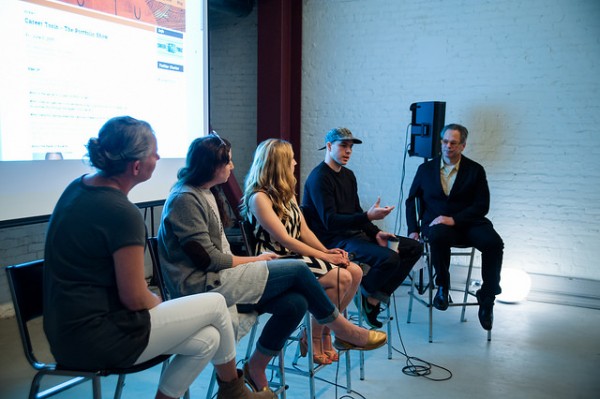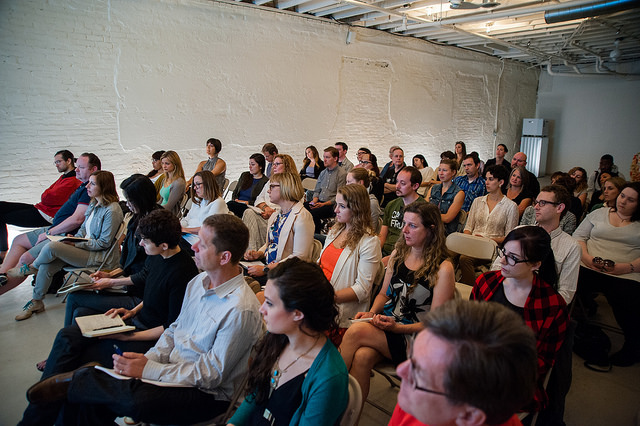
How do you make a killer portfolio that will help you get the job of your dreams?
AIGA Portland found out on June 4, 2015 when advising panelists JD Hooge, Partner and Chief Creative Officer at Instrument ; Kate Bingaman-Burt, Associate Professor of Graphic Design at Portland State University; Mary Blalock, Senior Talent Manager of 52 Ltd ; and Pam Lauwerens, Nike+ Design Operations Director at Nike met at the 52 Ltd office to share what it takes to capture their attention.
Big take-aways from The Portfolio Show
Exude passion and positive energy
“Have a presence and be super energized,” recommends Hooge. Include projects in your portfolio that you’re enthusiastic about. Never complain about a project. If you don’t feel good about it, don’t include that project in your portfolio or put a positive spin on it and explain how you solved the problem.
Your portfolio needs to be digital and have great UI
A first impression of your portfolio can be formed in 5 seconds, and the decision on whether or not to interview you can be made in as little as one minute. Lauwerens confessed, “If I go to the applicant’s website and I can’t find my way around, I’m done.”
Bingaman-Burt and Blalock suggest creating custom URLs in your online portfolio that focus on the type of work the company you are applying for is interested in. Then when you apply for a job at Nike, for example, you can send them a custom URL that features your apparel and sports work.
Panelists agreed that physical portfolios and leave-behinds are a thing of the past. Your work needs to be accessible online, and it is in your best interest to bring your own laptop and also a jump drive containing a copy of your portfolio just in case the office wifi and computers are down.
If there are particular print pieces you’re especially proud of, bring them to your interview.
Show and tell
Tell a story for each portfolio item and share your process. Be sure to fully explain your role and contribution for each piece in your portfolio, and how the work helped solve the client’s problem?Blalock encouraged designers to be prepared to talk about initial ideas, challenges encountered, and solutions to those challenges.
Keep it simple. Don’t over-design your portfolio.
All the panelists agreed emphatically that your portfolio’s design shouldn’t compete with the work you’re including in it. A portfolio tool like Behance is worth considering using, ease of updating and simplicity of presentation.
Be picky
Only include pieces you are proud of. Hiring managers are looking at your portfolio to determine your taste, so show some. Hooge suggested including 4 – 10 projects.
Different things matter when evaluating junior vs. senior candidates
For junior candidates, your taste is more important than your experience. A strong portfolio that shows that can get you an interview. Some companies — like Instrument — won’t even look at your resume until 5 minutes before you walk through the door.
It’s a little bit of a different game for senior applicants. Experience mattesr and this is where a solid resume and a good reputation come into play. Hiring managers want to see what clients you’ve designed for, where you have worked in the past, and the quality of your work and taste.
If your portfolio lacks diversity, it’s time to take on side projects
If you’ve been working as an in-house designer, your portfolio can quickly become full of work that all looks the same. You should seek outside projects to keep your portfolio fresh – whether freelance, pro bono gigs, or inventing your own projects. Working a full-time job and putting in the extra time to improve your portfolio can be difficult, but think of it as a necessary investment in your career path. The panel was quick to point out that Portland offers so many opportunities to get involved in community and hobby interest groups where you’re bound to meet someone who could use design help on their project.
Be prepared to quickly show why you’re the best candidate for the job
Mary reminded the audience that it’s entirely possible that the hiring company is so busy that your interviewer could only end up having 5-10 minutes to interview you. Decide in advance what project in your portfolio best proves that you’re a great fit for the job and be prepared to talk about just that project if need be. Don’t have your portfolio set up so that it forces a viewer to slog through a ton of details – make it easy for someone to quickly gain an overview of your work.
Do your basic job interview homework
Learn all that you can about the company and have some questions prepared for them to show that you’re applying because you love their work, not just because they have a keg tap in the office kitchen. Show that you love to geek out on the same things that they love to geek out on – let your inner design nerd shine proudly. Research typical interview questions and be ready to answer them, such as naming something you’re really good at and something you’re bad at. Also be prepared for the possibility that your interviewer could need you to lead the interview – have something short and interesting to say about each piece in your portfolio.
Portfolio must-have’s from the experts
JD Hooge’s must-haves:
- A demonstration of your taste level
- A very short bio that lets your personality shine through
- At least 4 pieces of work
Kate Bingaman-Burt’s must-haves:
- A layout that doesn’t distract from the work in your portfolio
- Something succinct to say about each piece
- No apologies for design decisions
Mary Blalock’s must-haves:
- Process descriptions – don’t be afraid to show wireframes
- What your role was on each project
- Simple, clean layout – do not over-design it
- Hyperlinks to specific sections of your site
Pam Lauwerens’ must-haves:
- A super clean layout that is focused on your work
- Include project descriptions
- Don’t include work you’re not enthusiastic about

Feeling inspired and ready to apply for jobs with your killer portfolio? See who’s hiring with AIGA’s job board and then sign up to be notified of our next Career Tools event, where every quarter we bring in industry experts to speak on a variety of topics to help you further your design career.
View more photos from the event.